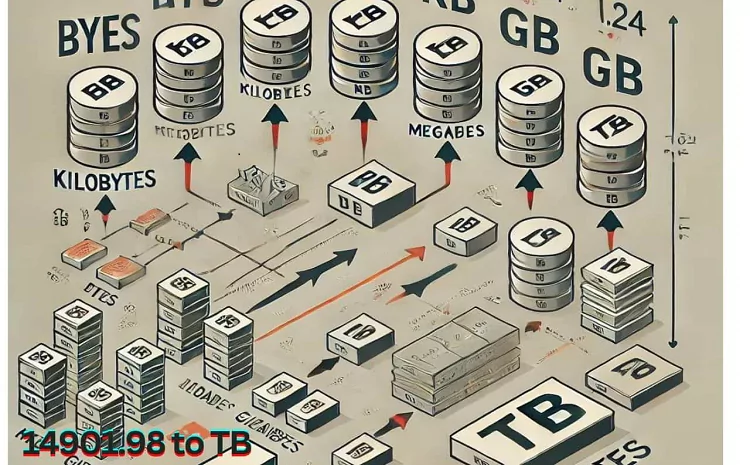In the world of digital storage, converting between different units is essential for efficient data management and understanding. One such conversion query is “14901.98 to TB.” This article breaks down what this means and how you can accurately perform such conversions.
Whether you’re a data scientist, an IT professional, or just someone curious about data sizes, this guide will walk you through every detail. By the end, you’ll have a solid grasp of data unit conversions and how to make the most out of this knowledge in various applications.
What is a Terabyte (TB)?
Before diving into the conversion process, it’s crucial to understand what a terabyte (TB) is. A terabyte is a unit of digital information storage that is often used to quantify large data sets. It comes after gigabytes (GB) and is a common measurement for everything from hard drives to cloud storage.
In computing, TB can be defined in two ways:
- Binary System (Base-2): 1 TB = 1024 GB
- Decimal System (Base-10): 1 TB = 1000 GB
Understanding these two systems is key to making accurate conversions.
Data Units and Their Conversions
Data storage units follow a hierarchy where each unit is a multiple of the previous one:
- 1 Byte (B) = 8 bits
- 1 Kilobyte (KB) = 1024 Bytes
- 1 Megabyte (MB) = 1024 Kilobytes
- 1 Gigabyte (GB) = 1024 Megabytes
- 1 Terabyte (TB) = 1024 Gigabytes
Or, in the decimal system:
- 1 Kilobyte = 1000 Bytes
- 1 Megabyte = 1000 Kilobytes
- 1 Gigabyte = 1000 Megabytes
- 1 Terabyte = 1000 Gigabytes
Relevance of 14901.98 in Data Storage
The number 14901.98 is not arbitrary—it often reflects specific data sizes or capacities in computing. For example, you might encounter such values when dealing with cumulative storage or data transfers.
Imagine you have multiple storage drives, each with varying capacities, and the sum of all these drives is 14901.98 GB. Knowing how to convert this value to terabytes helps you understand the total capacity more intuitively.
Converting 14901.98 to Terabytes: Step-by-Step Guide
Identify the Base System
Determine if you’re using the binary (base-2) or decimal (base-10) system. This will affect the conversion formula.
Use the Conversion Formula
If you’re using the binary system:
Terabytes (TB)=14901.981024≈14.56 TB\text{Terabytes (TB)} = \frac{\text{14901.98}}{1024} \approx 14.56 \, \text{TB}Terabytes (TB)=102414901.98≈14.56TB
If you’re using the decimal system:
Terabytes (TB)=14901.981000≈14.90 TB\text{Terabytes (TB)} = \frac{\text{14901.98}}{1000} \approx 14.90 \, \text{TB}Terabytes (TB)=100014901.98≈14.90TB
Verify Your Results
Check your calculations using online tools or software to ensure accuracy.
Practical Uses of Terabyte Conversions
Companies use TB conversions for various purposes, such as determining storage requirements for servers, cloud services, and databases. For instance, if a company needs 14901.98 GB of storage for its operations, converting this to TB helps in estimating the number of servers or storage devices required.
Common Mistakes to Avoid During Conversions
When converting between units, using the wrong base system is a common error. Always confirm whether you’re working with the binary or decimal system to avoid miscalculations.
Tools and Calculators for Data Conversion
Several tools can make these conversions effortless:
- Online Converters: Websites like UnitConverters.net offer quick conversions.
- Software: Programs like Microsoft Excel can be used for more complex calculations.
Data Management Best Practices
- Regularly Audit Your Storage Needs: Ensure that your storage matches your requirements.
- Use Compression When Possible: Save storage space by compressing large files.
- Understand Data Growth Patterns: Estimate future storage needs to avoid running out of space.
How TB Conversions Impact Cloud Computing and Data Centers?
Accurate conversions play a pivotal role in cloud computing. Providers often charge based on the amount of storage used, so understanding your needs helps optimize costs. Data centers also rely on these conversions for resource allocation and capacity planning.
Comparing TB with Other Storage Units
- Gigabytes vs. Terabytes: A TB is 1024 GB in binary or 1000 GB in decimal.
- Terabytes vs. Petabytes: 1 PB = 1024 TB in binary.
Understanding these relationships helps you choose the right unit for your needs.
Future Trends in Data Storage and Unit Conversions
With the increasing demand for data storage, units like exabytes and zettabytes are becoming more common. Expect to see new standards and conversion metrics as technology evolves.
Storage Capacity Limits
Every storage device has a limit. Knowing how to convert between units ensures you stay within these boundaries and make informed decisions.
Applications of Terabyte Knowledge in Different Fields
Different industries have unique storage requirements:
- Healthcare: Medical records and imaging data require large storage capacities.
- Finance: Secure storage for transaction data.
- Technology: Efficient storage and retrieval of application data.
Conclusion
Converting 14901.98 to TB is a straightforward process when you understand the basics of data units and the different base systems. Mastering these conversions is crucial for anyone working with digital data, whether you’re in IT, finance, or cloud computing.





